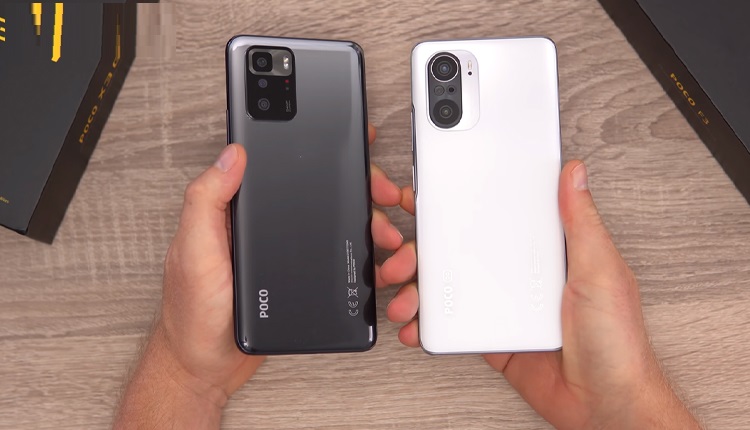Comparison of Xiaomi Poco F3 and Poco X3 GT
Today, we go to two of the most affordable and popular phones in the market, namely Xiaomi Poco X3 GT and Poco F3, to compare the two products to determine the best option for users.
Xiaomi Poco F3 and Poco X3 GT have many similarities and are in the same price range; therefore, in this article, we try to look at the strengths and weaknesses of each of these phones and compare the two products with each other to determine the best option for users.
Design, body and build quality
One of the most important issues for many users is the design and build quality of the phone. The Poco F3 and Poco X3 GT may be similar in design to the front; but when it comes to the back of these phones, this is where the differences come into play.
The Xiaomi Poco F3 has a body with a plastic frame, but the back cover and front panel are made of Gorilla Glass 5 hardened glass. On the other hand, the Poco X3 GT, like the Poco F3, has a plastic frame, but its front panel glass uses the latest generation of Gorilla Glass or Vickets; Unfortunately, the back cover of the phone is not made of glass and is made of plastic.
The design language used on the back of the two phones is also different; The Poco F3 in blue, which we examined, used a special folded pattern on the upper part of the back, and in the lower part, we saw two parts with an angled pattern, each of which acted uniquely in reflecting light. And the Poco logo can be seen in one of them; Of course, the white and black colors of Poco F3 have a simple design and there is no special pattern behind them. The camera lenses of this phone are reminiscent of the design of Xiaomi Mi 11 series lenses.
Display
Perhaps one of the main differences between the Poco F3 and X3 GT is the display. Poco F3 uses a 6.67-inch OLED display with a resolution of 1080 x 2400 and a refresh rate of 120 Hz; On the other hand, the Poco X3 GT uses a 6.6-inch IPS LCD display with a resolution of 1080 x 2400 and a refresh rate of 120 Hz. The display of the Poco F3 supports HDR10 + content, while the display of the Poco X3 GT only supports HDR10 content.
The OLED panel used in the Poco F3 has a much better quality and viewing angle than the Poco X3 GT IPS LCD panel. It may not be news that OLED panels are of better quality than LCD panels; But given the relatively similar price of these two phones, it should not be overlooked. Also, due to the use of the IPS LCD panel in the X3 GT, it is not possible to use the Always-On Display feature or the always-on screen with this phone; This feature is found on the Poco F3.
The two panels do not differ much in terms of maximum brightness, and the performance of both in this area is a bit disappointing. Both of these monitors have a refresh rate of 120 Hz, but after launching, the phone is at 60 Hz by default, and you must enable this option by going to the Settings menu and the Display section.
hardware
When it comes to comparing the chipsets of these two phones; We will find that the Poco F3 also has a significant advantage over its competitor in this regard. The Xiaomi Poco F3 uses the Qualcomm Snapdragon 870 chipset, which is an improved version of the Snapdragon 865 processor from years ago, and also supports 5G. The GPU of this product is Adreno 650, which is one of the most powerful mobile GPUs. The base version comes with 6GB of LPDDR5 RAM and 128GB of UFS 3.1 internal storage, and a version with 8GB of RAM and 256GB of internal storage is also available.
On the other hand, the Xiaomi Poco X3 GT uses the MediaTek Dimension 1100 chipset, which is a high-end chipset with a 5G modem. The graphics processor used in this phone is a financial type of G77, which also has a good performance. The phone comes with 8 GB of LPDDR4X RAM and 128 GB of internal memory and UFS 3.1. A version of this phone with 256 GB of internal memory is also available.
Software and user interface
Given that these two phones are made by one company; We may see the least possible differences in this section. Both phones come with Android 11 operating system and their user interface is MIUI 12.5. Of course, the launcher of these two phones is different from what we are used to in other Xiaomi phones, because both of them use the exclusive launcher of Poco Launcher.
This launcher looks simple and close to raw Android, and you can swipe up to the apps menu, which by default categorizes your apps by usage; Get access. If you swipe left on the main page, you will also enter the Google feed, which brings personalized news along with weather conditions, traffic, results of sports matches, and so on.
The only major difference between the two phones in terms of user interface is the inability to use the Always-On Display feature or the always-on display on the Poco X3 GT, which has an IPS LCD display.
The two phones use the same version of the Android operating system and have the same user interface and launcher; Therefore, it is not possible to determine a winner in this section.
Battery
Let’s compare the battery and charging speed of these two phones. The Xiaomi Poco F3 comes with a 4520 mAh battery and also supports 33 watt fast charging; Fortunately, Xiaomi has not removed the charger from the packaging of these phones, and a 33-watt charger is inside the box.
The Poco X3 GT uses a larger battery with a capacity of 5,000 mAh and also supports fast 67-watt charge, and a special 67-watt charger is included in the box.
Both phones perform well in terms of battery life and will meet the needs of the user for more than a day; But thanks to more capacity and the absence of high-consumption features such as Always-On Display, it must be said that the Poco X3 GT battery lasts longer than the Poco F3 battery.
Charging speed is also higher in Poco X3 GT; It takes about 45 minutes to fully charge, which is a bit faster than the one-hour full charge of the Poco F3, which also has a smaller battery.



